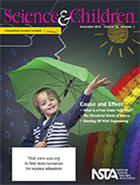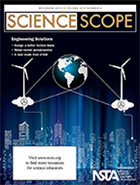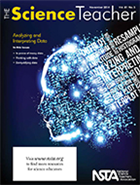NSTA journals: A goldmine for teachers
By Mary Bigelow
Posted on 2014-11-19
One of the perks of being an NSTA member is having access to all of the journals online. Regardless of the grade level you teach, the journals have ideas for authentic activities and investigations that can be used, adapted, or extended for different levels of student interest and experience. The articles in NSTA’s November K-12 journals focus on the crosscutting concept of Cause and Effect, Engineering Projects, and the practice of Analyzing and Interpreting Data.
 Science & Children: Cause and Effect
Science & Children: Cause and Effect
This issue continues a series that addresses each of the crosscutting concepts with “snapshots” of activities that include the concepts. Here are some SciLinks that provide additional content information and suggestions for additional activities and investigations related to this month’s articles:
- Teaching Through Trade Books–What Goes Up Must Come Down! [Gravity, Newton’s Laws]
- The Early Years—Cause and Effect: Where’s the Evidence? [Newton’s Laws]
- Formative Assessment Probes—Seeds in a Bag [Seed Germination]
- The Wonderful World of Worms [Worms]
- Real-World Units in the Conceptual Age [Forces and Motion, Force and Friction]
- What Is a Foot Under Your Feet? [Soil]
- STEM in a Hair Accessory [Cancer]
- Engineering Encounters—Blasting Off With Engineering [Rockets]
Note: Last month’s Science Scope also addressed Cause and Effect!
Science Scope: Engineering Solutions
This issue describes a number of STEM-based activities that will help turn students into the problem solvers of tomorrow. Two other organizations have excellent resources for engineering projects and lessons: TeachEngineering and TryEngineering. Both of these have ideas for lessons that focus on authentic problem-solving.
This month’s Teacher’s Toolkit article Exploring the science Framework and NGSS: Computational thinking in the science classroom is a must-read for all science teachers. It’s a good description of the similarities and differences between mathematical and computational thinking (hint: they’re not the same!).
Here are some SciLinks that provide additional content information and suggestions for additional activities and investigations related to this month’s featured articles:
- Engineering Design and Effects [Water Cycle, Solvation of Solids in Water, Water Quality, Watersheds and Pollution]
- Saving Pelicans (could be modified for any migratory bird) [Bird Adaptations, Migration of Birds, Biodiversity, Food Webs]
- Redesiging the Water Rocket [Rockets, Projectile Motion, Force and Motion]
- Designing Earthquake Resistant Structures [Earthquakes, Earthquakes and Society]
 The Science Teacher: Analyzing and Interpreting Data
The Science Teacher: Analyzing and Interpreting Data
As students become more adept at accessing, storing, and sharing data, they need to develop the skills and habits of mind necessary to analyze and interpret this data to produce useful information. The Next Generation Science Standards recognize Analyzing and Interpreting Data as one of the eight essential practices of science and engineering. This issue offers ideas for including this important practice in the classroom.
Here are some SciLinks that provide additional content information and suggestions for additional activities and investigations related to this month’s featured articles:
- In Praise of Messy Data [Life on Other Planets]
- The Graph Choice Chart [Graphing Data, Presenting Scientific Data]
- Reflecting on Data [Reflection, Mirrors]
- Demystifying Data [Climate Change, Measurements and Data]
- Thinking with Data [Statistics in Science]
Disclaimer: The views expressed in this blog post are those of the author(s) and do not necessarily reflect the official position of the National Science Teaching Association (NSTA).

